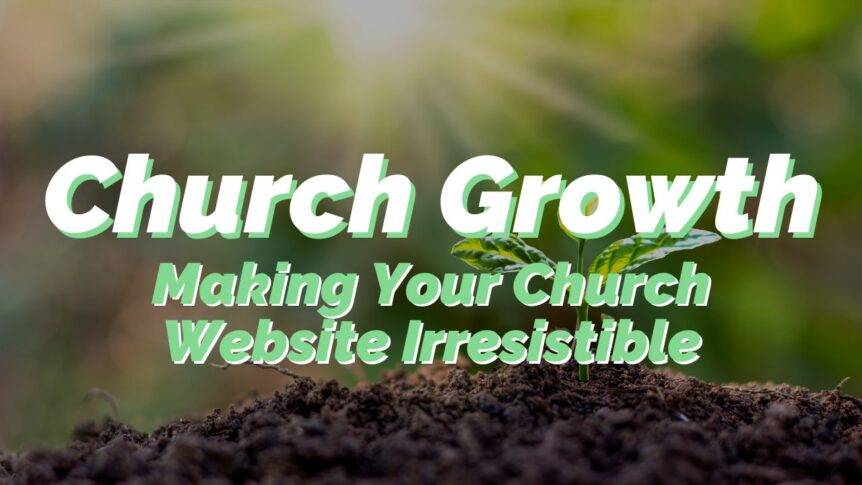Growing your church is a complex task. There are a hundred factors all making a difference, most of which you have no control over. Even so, there is one major thing you can do to attract people to your church: making your church website irresistible to visitors.
In today’s digital age, most Christians check out a church’s website before visiting it in-person. Your website has the power to inform, engage and turn visitors into life long members. However, if your website turns visitors away, they’ll never even try your church. All it takes is a little effort to turn any church site into something engaging and irresistible.
In this article, we’ll cover everything you need to know to grow your church in the 21st century. Then, we’ll explore the top 7 ways you can make your church website irresistible to visitors. With some time, energy, and luck, you’ll be growing your church in no time.
Ready to learn more? Let’s jump in.
Estimated reading time: 10 minutes
Table of contents
Growing Your Church

First up, let’s explore what you need to know about growing your church. We’ll cover building a strong church family, engaging your local community, and why a church website is important to your church growth strategy.
Building a Strong Church Family
One of the most important aspects of church growth is cultivating a strong church family. The term “church family” refers to the close-knit community of believers who attend and participate in your church. This sense of family is crucial for church growth because people are more likely to join and stay in a community where they feel connected and valued. To build a strong church family, focus on creating a welcoming and inclusive environment.
Encourage church leaders to actively engage with members, making them feel seen and heard. Hosting regular community events can help bring members together, allowing them to form deeper bonds. Additionally, your church’s mission statement should clearly communicate your commitment to fostering a loving and supportive community, helping potential members understand what your church stands for and why they should become part of it.
Engaging the Local Community
Engaging with the local community is another key strategy for church growth. Your church should be seen as a vital part of the neighborhood, actively contributing to the well-being of the people around you.
Hosting community events, such as charity drives, free meals, or holiday celebrations, can draw people to your church building and introduce them to your church family. These events not only provide opportunities for outreach but also allow your current members to serve and connect with others, reinforcing their commitment to the church. Church leaders should also consider collaborating with local organizations or schools to further integrate the church into the community.
When people see your church actively involved in making a positive difference, they are more likely to want to be a part of it. Additionally, ensuring that your church’s mission statement is reflected in these community activities can help attract those who share similar values and are looking for a church home that aligns with their beliefs.
The Importance of a Church Website
In the modern age, having a well-designed and informative church website is essential for church growth. A website serves as the online face of your church, making it easier for people to learn about your mission, values, and community before they even step foot in the church building.
According to Lifeway Research, 84% of Protestant churches have a church website. It’s just not something you can put off any longer.

Your website should be easy to navigate, with clear sections that provide information about service times, upcoming events, and how to get involved. Including a section about your church’s mission statement can help visitors understand your core beliefs and goals. The website should also feature a section for new visitors, explaining what they can expect when they attend a service. Highlighting recent community events and showcasing testimonials from current members can give potential attendees a sense of your church family.
Additionally, offering online registration for church membership or sign-ups for events can make it more convenient for people to get involved. In short, a strong online presence through a well-maintained website is crucial for reaching new members and supporting church growth.
Growing your church in the modern day involves building a strong church family, maintaining a robust online presence through a well-designed website, and actively engaging with the local community. By focusing on these areas, you can create a thriving and welcoming environment that attracts new members and supports the ongoing growth of your church.
Top 7 Ways to Make Your Website Attractive

And that’s what you need to know about growing your church in the modern age. Now we’re going to jump into 7 church growth ideas to make your website more attractive to visitors. As we explored, a church website is vital to a church’s growth in today’s day and age. With these church growth strategies, you’ll get your website to stand out above the rest.
Let’s dive in.
1. Avoid Driving Visitors Away
Obviously, the first step is to avoid driving visitors away to begin with. We’ve covered church website mistakes before and it’s vital to look over your website and make sure it’s not making any of those errors. Your website is capable of helping boost your church attendance and membership, but only if it’s not turning visitors away at the digital doors.
In case you haven’t seen the article or it’s been awhile, the 7 biggest church website mistakes are:
- Pastor Focused Homepage
- Building Focused Homepage
- A Church Website That’s Not Mobile-Friendly
- Not Adding Text to Your Sermons Page
- Hidden Service Times
- No Calls to Action
- Out-Of-Date Information
2. Show The Real Church Experience
You want to show visitors how much fun your church is, but it’s easy for visitors to tell real from fake. The entire reason someone is checking out your website is to get an idea of what your church’s community and atmosphere is actually like. If the website shows one thing, but your service is something else entirely, visitors won’t come back.
Start by including real photos, instead of stock photos, of your church groups, pastor, and staff members. When a visitor does attend a service, they’ll instantly recognize the people they saw online. Think of your church like a business. Clients want to know who they’re working with, just like visitors want to see the actual church in action.
If your church is more fun loving, showcase that in images, blog posts and other site content. If it’s more serious, showcase that. When someone’s trying to find the right church, it’s vital that your site shows them what to expect.
3. Guide Visitors To What They Need
Simple and intuitive navigation is crucial for any website, not just church websites. It should be easy for visitors to get from point A to point B on your site with ease. However, you can take navigation a bit further and make your site so easy to use that it’s irresistible.
When growing your church, think about the type of members you want to target. Do you want to target younger members, families, singles and/or seniors? Include areas on your site for different types of members. For instance, include a menu for parents or families that includes details on child-specific services, classes, and events.
4. Answer All The Basic Questions

Any church website that doesn’t answer all the basic questions that a potential church member might want to know is instantly going to drive that visitor away. Growing your church means thinking ahead to what a visitors wants and needs to know. For instance, you’d need to include service times, which door(s) to enter by, type of dress (include images of members), how long services last, what type of community service the church might be involved in, number of current members and what denomination or if you’re a non-denominational church.
5. Keep The Message Welcoming To All
If your church’s site only caters to members, you’re going to have a difficult time growing your church with your website. For instance, if your blog posts only focus on upcoming events and provide short text, such as “We still need volunteers for Saturday’s bake sale. Please contact Sarah to sign up.”, visitors might feel like your church’s community isn’t welcoming to new visitors.
When posting content on your site, ensure it’s engaging to both members and visitors. Show visitors that you’re eager to welcome them.
6. Offer Free Podcasts
While some churches may argue against podcasts, the truth is, visitors still want to know what a typical service is like. The podcast isn’t going away anytime soon, mainly because it’s too convenient. The one thing that podcasts don’t offer is the community aspect, which is what most church members love most.
Offer the convenience to worship on the go, but go a step further. Include conversations with members at the end. Let listeners hear how involved members are and the type of community they could be a member of themselves. Add an online donation feature so online listeners can help support the church too.
7. Make It Look Good
Making your church website look good is essential in today’s digital age. Many churches now have websites, so it’s important to stand out. A clean, simple design with easy navigation helps visitors find what they need quickly. Use high-quality images of your church building, church family, and community events to create a welcoming feel. Consistent colors and fonts that match your church’s branding give the site a polished look.
Include clear, engaging content that reflects your mission statement, making it easy for people to understand what your church stands for. Highlight upcoming events and ways to get involved to show that your church is active and inviting. Remember, a well-designed website is often the first impression people get of your church, so it should reflect the warmth and vibrancy of a thriving church.
Church Website Growth

In conclusion, making your church website irresistible is a powerful way to grow your congregation. Your website is often the first place people will visit before stepping inside your church walls. By creating a welcoming and easy-to-navigate site, you invite potential members to explore what your church has to offer.
Highlighting your Sunday services, community events, and ways to get involved helps newcomers feel connected before they even attend. A strong, engaging website reflects the dedication and passion of your church leader and the entire church family, showing that your church is a place where people can find a home. Remember, an irresistible website is more than just a digital space—it’s a doorway that can lead many to experience the warmth and love within your church walls.
One of the easiest ways to find new members is by taking your church online. Let your website be your starting point. Turn it into a true representation of your church and make it easy and welcoming for anyone to use.
Ready to make your church’s site irresistible? Start with our free website strategy review to receive custom feedback on how to perform better.





Comments 1
Another great post Thomas! I specifically like the advice and reference on “keeping your message welcoming to all.” You definitely need to be careful with internal language. Even though it is great to promote member unity/involvement, you have to always imagine yourself as a potential first time visitor on your site.